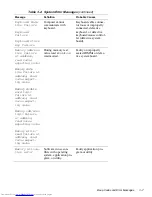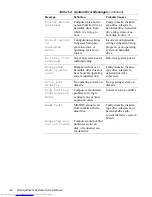
2-6
Dell OptiPlex N Systems Service Manual
3. Observe the monitor screen for the Diagnostics Menu.
This menu lets you choose the following options or exit to the MS-DOS
®
prompt:
•
Run Quick Tests — Runs selected tests from all test groups to quickly
locate a failure or to indicate where further testing is needed to isolate a
failure
•
Run All Tests — Runs all tests for a thorough test of the computer
•
Run Specific Tests — Tests a particular area or subsystem
If the Diagnostics Menu does not appear, check with the network adminis-
trator to determine if the service partition was removed from the hard-disk
drive. If it is not possible to run the hard-disk–based diagnostics, and if you
are prepared to open the computer, proceed to the next section, “Internal
Visual Inspection.” Otherwise, see “Getting Help” found later in this
chapter.
The diskette-based diagnostics consists of the following test groups:
•
RAM Tests — Check all the directly addressable RAM
•
System Set Tests — Check the computer’s system board components and
verify their related functions
•
Video Tests — Verify proper operation of the video controller and the video
control circuitry
•
Keyboard Tests — Verify the correct operation of the keyboard and the key-
board controller chip
•
Mouse Test — Checks the functionality of the mouse controller and the
operation of the mouse keys
•
Hard-Disk Drive Tests — Check the hard-disk drive controller and the stor-
age capability of the hard-disk drive
•
Serial Ports Tests — Check the computer’s interface with external devices
connected through the serial ports
•
Parallel Port Tests — Check the computer’s interface with external devices
connected through the parallel port
•
Network Interface Tests — Verify the basic operation of the network inter-
face controller, including read and write access to its registers and internal
transmit and receive capability
For a complete description of the hard-disk–based diagnostics, see “Hard-Disk–
Based Diagnostics” in the online Network Administrator’s Guide.
NOTE: Further troubleshooting requires access to the inside of the computer. If
you do not want to open the computer, proceed to the last section in this chapter,
“Getting Help.”
















































